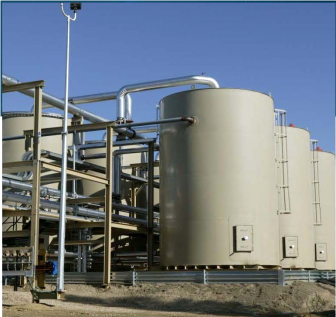Wireless Tank Level Monitoring Optimized with SignalFire’s Open Architecture Mesh Network
Tank level monitoring is one of the most common wireless applications in upstream oil and gas. SignalFire’s Remote Sensing System features an open architecture mesh network that provides a number of benefits over other competitive technologies for tank level monitoring including choice of sensors, truly wireless capacity and easy configuration.
User-Selectable Sensors: Many tank level technologies limit interfaces to one or two types of sensors. However, the materials (oil, water, etc.) being monitored and the environment must dictate the best sensing technology. The right sensor for the job might be a radar, float, pressure sensor, ultrasonic sensor, piezo resistive sensor or guided wave radar. SignalFire provides wireless modules that have an open architecture with industry standard interfaces to permits the user to choose the sensor type that is best for the application. Sensors are easily integrated it into the SignalFire Mesh Network. Supported interfaces include 1-5V, 4-20 mA, Modbus, Hart, and Digital Inputs.
Truly Wireless: If a sensor must be powered, the system is not truly “wireless”. SignalFire’s systems can power both the attached sensor and the radio system from either internal batteries or a specially-designed solar system. Battery life depends heavily on the choice of sensor but can range from 1 to 10 years.
IntrinsicallySafe: SignalFire’s Sentinel nodes meet Class 1 Division 1 certification for use in hazardous locations. Replaceable battery packs also meets these requirements and can be changed in hazardous areas. Specially designed and C1D1 certified solar power systems can be used in the hazardous location for high power draw sensors or applications requiring a rapid reporting interval.
Easy Configuration: A SignalFire Toolkit PC software makes system configuration easy through a graphical interface. Raw analog values can be converted to units of measure and polling frequencies and power settings can be configured using the tool kit. For HART sensors that require in situ calibration, such as guided wave radars, SignalFire offers a Wireless PACTWare and Radar Master support. This allows a user to configure a remote sensor wirelessly from a connection to the Gateway. If an Ethernet Interface module is used with the gateway, a HART sensor can be configured remotely from your office.
Cost Effective: A truly valuable wireless system must deliver economic value to the customer. SignalFire systems are competitively priced when compared with 50 to 100 feet of installed conduit. In addition, systems can be completely pre-configured in the shop, greatly reducing field installation time
Download our new Wireless Remote Asset Monitoring & Control brochure.
Contact us directly at support@signal-fire.com.
0 Comments
Leave a reply
You must be logged in to post a comment.






